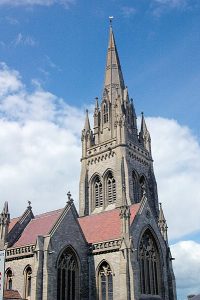All Saints Church, Ryde

All Saints Church dominates the skyline with its 186 feet steeple rising from a pinnacle tower. It is a fine example of a Victorian Decorated Gothic church. Designed by Sir Gilbert Scott, more famous for designing the Albert Memorial and St Pancras Station, London, it was built in three phases between 1869 and 1891.
HRH Princess Christian of Schleswig-Holstein laid the cornerstone in 1869 on behalf of her mother Queen Victoria. The nave, chancel and sanctuary were complete by 1872 when the Right Rev Samuel Wilberforce, Bishop of Winchester, and former Rector of Brighstone, consecrated the Church.
The architect’s son, John Oldred Scott, designed the tower and spire added in 1881 and 1882. Finally, the cloister, crypt and octagonal vestry, designed by C Pemberton Leach who had a family connection with Ryde, were completed in 1891. The Church has a fine ring of eight bells cast by Messrs Taylor & Co in 1886.
In Ward Lock & Co’s Guide of 1919, it states many authorities considered All Saints to be “the finest parish Church in the south of England”. The nave has soaring arcades of six bays, the piers all having a different variety of foliage carved on the capitals with a similar design on the roof trusses.
Equally impressive is the beautiful alabaster and marble font standing at the west door, designed by Sir Gilbert Scott to commemorate the recovery from serious illness of the Prince of Wales (later Edward VII). The oak font cover, designed by an unknown local craftsman, is in memory of a parishioner, Mrs Harding.
There are two other significant designs of Gilbert Scott’s in the Church. One is the pulpit of Derbyshire alabaster marble columns that won first prize in its class at the Great Exhibition of 1851. The figures arranged in pairs represent: St Peter and St Paul (apostles); Isaiah and Jeremiah (prophets); St John the Baptist and St Barnabas (preachers); St Stephen and St Alban (martyrs); the Virgin Mary and St Mary Magdalene and St Catherine and St Agnes.
The other example is in the Sanctuary. It is the altarpiece and reredos in alabaster and coloured marble behind the High Altar that depicts scenes from the Passion and Crucifixion. The altar table made from olive wood from the Holy land, dates from 1885. On the walls are fine murals designed by Clayton and Bell and, although they are now faded, they are still beautiful.
Most of the original stained glass was also by Clayton and Bell, but unfortunately, the Church lost much of this during World War Two. The best of the original glass is in the east window illustrating the “Te Deum”. There is a beautiful window from 1913 of the Nativity by Ion Pace next to the north door. An example of modern stained glass is in the west window, replaced in 1951. It is by Lawrence Lee and depicts “Lord in Glory” and the “Saints’ pilgrimage”.
At the east end of the north aisle is the War Memorial Chapel consecrated in 1920 to the memory of those who died in World War One. It was erected at the same time as the Calvary, a representation of the passion and crucifixion of Christ, standing outside on the northeast corner looking down over the town. The Calvary now lists the names of those who lost their lives in the First and Second World Wars.
The Chapel of the Good Shepherd (formerly the vestry) stands at the end of the south aisle; it also has a beautiful reredos in alabaster and coloured marble designed by C Pemberton Leach. The four-light window over the altar depicts Psalm 23, “The Lord is my Shepherd”.
The Church is very proud of its organ built by one of the greatest organ builders, “Father” Henry Willis in 1874. It was restored and electrified by his great-grandson Henry Willis IV in 1985; much of the original pipe work remains.
An interesting feature of the Church is the dignified North Porch erected to the memory of Prince Albert by members of the Royal Victoria Yacht Club. Over the centre is a niche containing a seated figure of Our Lord, his right hand raised in blessing. Figures of St John and St Andrew are in the other niches. All Saints has marvellous acoustics and is popular venue for visiting choirs and concerts.

Excerpt from RSHG’s book Ryde’s Heritage: Our Town, Your Histories published June 2008
